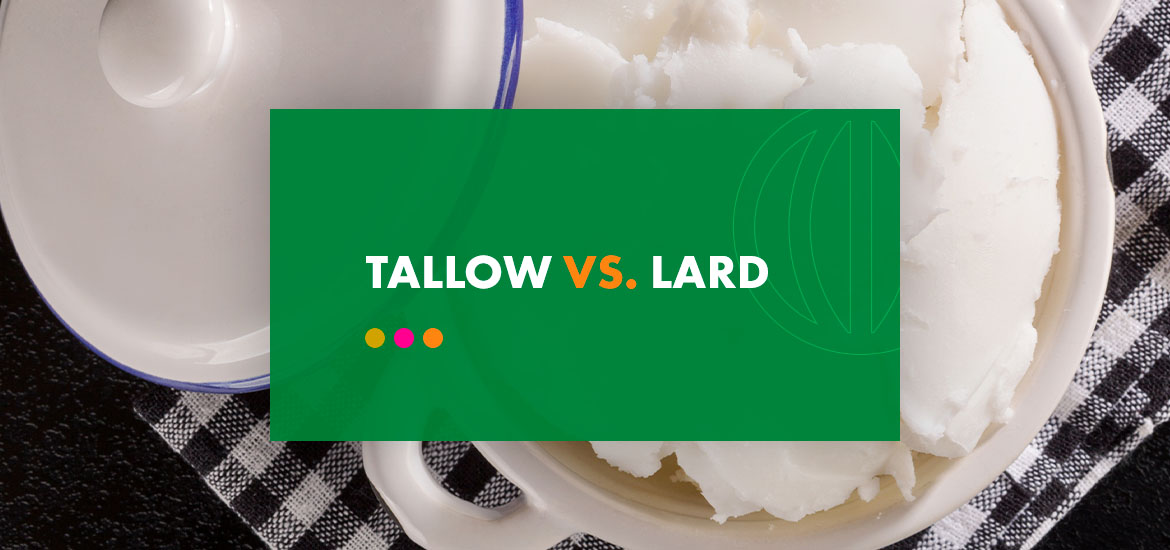Tallow vs. Lard
Various fats and cooking substances are useful in many applications. From cosmetic production to diesel fuel alternatives, cooking oils provide a steady base, beneficial properties and a consistent texture. Two popular options are tallow and lard. Tallow is made from beef fat, while lard comes from pork fat. Both choices have nutritional benefits and can suit a wide range of applications.
However, the two fat types also have differences that set them apart. Learning these variations helps users decide whether tallow or lard is best for their purposes.
What Is Beef Tallow?
Tallow is a rendered version of beef fat. It has a solid composition and becomes malleable at certain temperatures. Tallow typically derives from cattle or sheep fat during a process called rendering. Here, fatty tissue is boiled and spun through a centrifuge, which eventually separates the fat and other liquid. You can use the remaining fat for a wide range of applications.
Tallow consists of these fats in the following ratios:
- 50% saturated fat
- 42% monounsaturated fat
- 4% polyunsaturated fat
Rendering fat from beef results in a signature taste and structure. It has a similar appearance and consistency to butter but a drier, more waxlike texture.
What Is Lard?
Lard is rendered pork fat. As with tallow development, manufacturers use rendering to separate the fat from other elements. You can also use other methods to obtain the substance. Areas like the pork belly, pork butt or pork shoulder offer the largest amounts of lard on the animal. Lard consists only of saturated and unsaturated fats and contains no trans fats.
Depending on the creation process, lard is available in various types:
- Rendered lard: Rendered lard is melted and filtered from the source. It has a white color and smooth texture. You can purchase rendered lard through vendors or complete the rendering process at home with the proper equipment.
- Leaf lard: Leaf lard comes from a particular portion of pig fat — a leaf-shaped section by the animal’s kidneys. Many consider leaf lard to have the best taste and consistency for baking and other applications.
- Processed lard: Processed lard undergoes additional hydrogenating that makes it suitable for long-term storage, such as grocery store purchases. It’s firmer than other types since it undergoes more processing.
What Are the Differences Between Tallow and Lard?
Tallow and lard have several similarities that cause confusion — they are both useful cooking oils with lengthy shelf lives. However, the two have significant differences that can make one option more suitable than the other for specific purposes.

Learning the differences between tallow and lard will help you understand which product better suits your needs. These are the major variations between the choices:
- Sources: One of the most significant differences in these substances is their origins. Tallow is made from beef fat, while lard consists of pork fat. The variation in sources creates distinctive flavors and textures.
- Hardness: Tallow is slightly harder than lard and has a texture similar to solid butter or a bar of soap. Lard is softer and easier to spread, which can make it a better choice for certain cooking applications.
- Tastes: The options also vary in taste, which has a significant impact on cooking. Lard typically has a neutral taste and does not add additional flavors or odors to products. Tallow has a richer flavor similar to that of beef. Depending on your product and preferences, you might want strong flavors or no additional taste.
- Nutritional values: Some buyers choose between tallow or lard based on their nutritional value. Tallow contains various nutrients that benefit the body, including Vitamins A, B, E, K and B12. Tallow also consists of conjugated linoleic acid (CLA), a fat type that can help reduce body fat and enhance immune processes. Lard has slightly fewer nutritional benefits than tallow but does offer a significant amount of Vitamin D.
What is Tallow Good For?
Tallow is a versatile product with many applications. You’ll often see this substance used for the following purposes:
- Cooking: You can integrate tallow into food or use it to grease pans. Users may fry or sauté foods in tallow to add its rich, beefy flavor to meals. Another common application is incorporating tallow into pie crusts or pastries to strengthen their composition and boost their flavor profile. Outside of foods, some people use tallow to condition or moisturize kitchen items like wooden cutting boards or spoons.
- Cosmetic manufacturing: Tallow is also a frequent component in various cosmetic products, where it can be an ingredient or serve as its own solution. For instance, tallow balm is often used as a skin moisturizer because of its nourishing capabilities. People apply tallow balm to soothe eczema, acne and other skin conditions. In addition, manufacturers add tallow to products like soap, hair conditioner or sunscreen, where its vitamin content allows it to moisturize and strengthen various bodily areas.
- Renewable diesel production: Tallow can undergo various processing techniques to become a component of renewable diesel. As more manufacturers turn to sustainable solutions, renewable diesel production strategies become more important than ever. This product is a more environmentally friendly and sustainable alternative to petroleum-based diesel, which can emit pollution and greenhouse gases when burned. Using tallow for diesel production also helps optimize the use of animal byproducts to reduce waste.
- Lubricating: Tallow is an excellent lubricant for many applications, as its naturally slippery texture allows parts to move against each other smoothly. It is often applied to industrial machines because it will continue to provide lubricity even when exposed to cleaning liquids and vapors. Engineers apply tallow to keep electrical conduits running smoothly, and firearms and other products prone to rust formation can benefit from tallow application to keep moisture at bay. Tallow lubricants are particularly valuable in food processing facilities, as petroleum lubricants are not ideal for equipment in this environment due to food contamination risks.
- Candle-making: Manufacturers commonly use tallow for candle production. The fat maintains its shape once formed, helping the candle stay firm and upright. It also burns slowly and emits a strong source of light when paired with the right wick material.
Contact Baker Commodities Today
Tallow has uses in many industries, from cosmetics to food production. If you’re seeking large volumes of high-quality inedible tallow products, reach out to Baker Commodities today.
We recover and convert materials into inedible tallow to make this valuable product available for commercial use. Our team has decades of experience with rendering animal fat, providing healthy solutions from renewable sources. Our commitment to sustainability and high-quality products makes us an ideal fit for many industries, from industrial applications to farms.
To learn more about our tallow processing or to purchase our products, contact Baker Commodities today.




